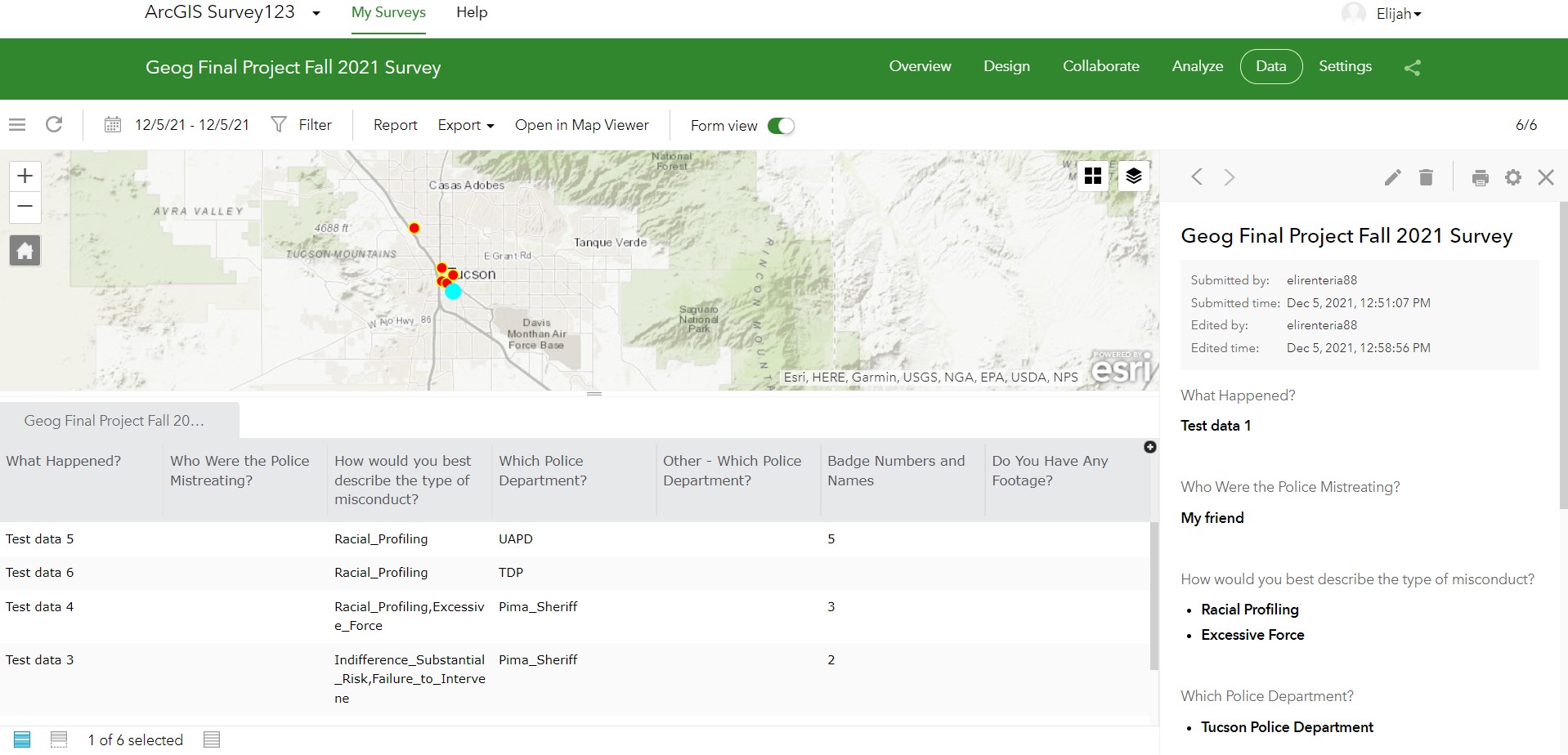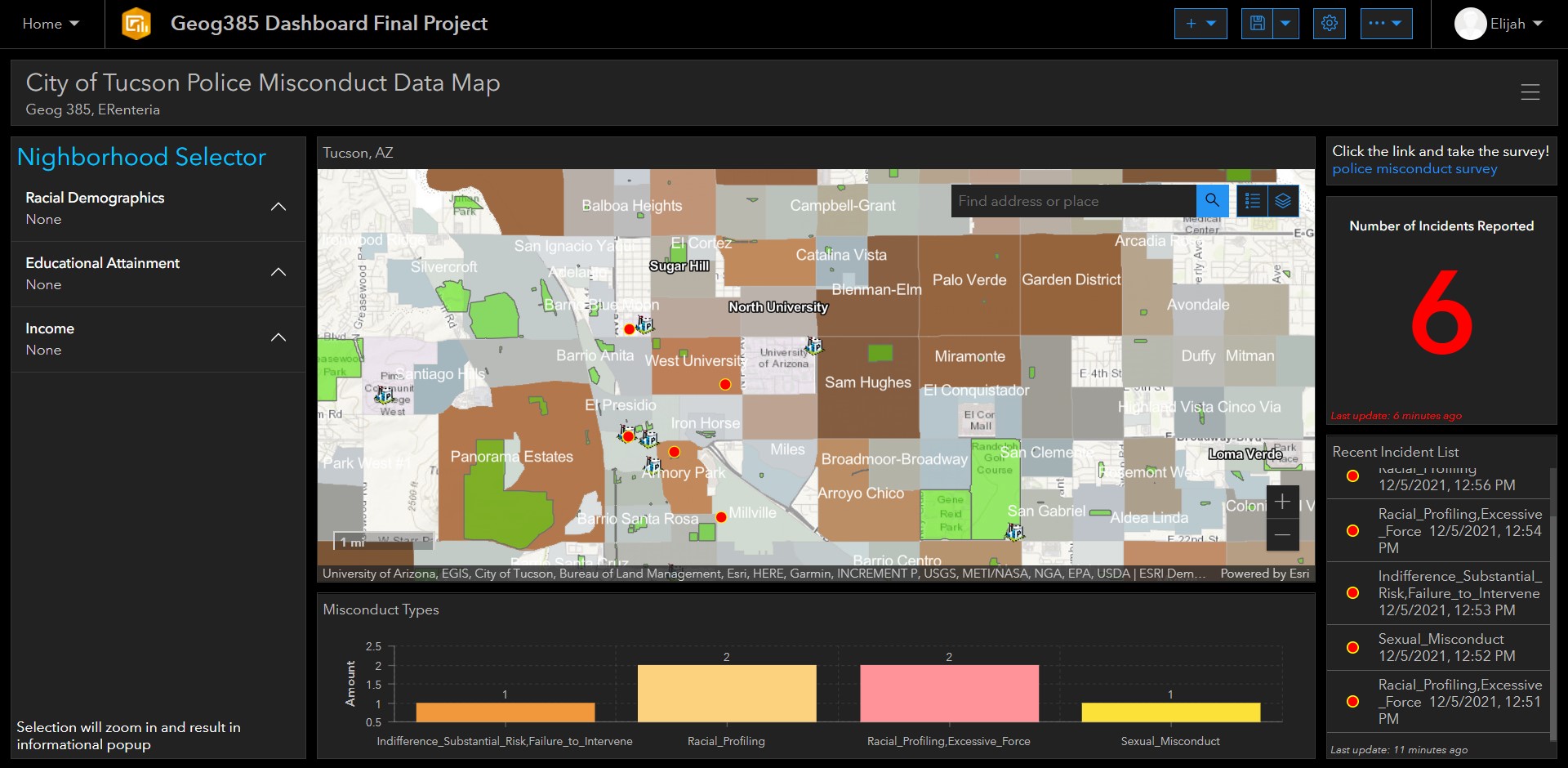
Figure 2


Figure 3


Figure 4

Analysis
I found some issues with creating webmap in the dashboard. I was unable to find an easy way to switch layers on and off, although it is possible within the map widget. The labels were also distracting, and there were issues in arcgis online formatting them so that they only appeared when zoomed in. I was able to fix several of the layers, but some didn’t work correctly. I initially wanted to focus on Los Angeles, but found that data for my hometown of Tucson was smaller and more accessible for a proof of concept. I also decided to not circulate the survey to friends and family or the public to collect test data, because of the sensitivity and implications of the data that could be collected. Instead I filled out several surveys with a little information just to see if the project would work. Other than that the process went smoothly.
Conclusion
I am actually quite pleased with the final project result. The survey integrates well with the webmap and the dashboard, which was my biggest fear. I think the services could be improved with input from activists and groups focused on this type of work, especially with making the survey questions more accessible and targeted, as well as what data would be most useful to display on a dashboard. My hope would be that the dashboard would be something that users, perhaps using social media, could easily interpret and use for educational purposes and I think input from relevant groups would be helpful in that regard. At the moment, some of the dashboard applications are not very self explanatory, and could be improved. Overall, I think this project serves as a proof of concept, and shows that this type of data (geospatial police misconduct data) can be collected from the public and utilized in useful ways. Future research could look at how activists are collecting data on police misconduct, and work together with organizations to create a more focused application. .
References
Lawton, B. A., Piquero, A. R., Hickman, M. J., & Greene, J. R. (2001). Using GIS to Analyze Complaints Against Police: A Research Note. Justice Research and Policy, 3(2), 95–108. https://doi.org/10.3818/jrp.3.2.2001.95

Analysis
I found some issues with creating webmap in the dashboard. I was unable to find an easy way to switch layers on and off, although it is possible within the map widget. The labels were also distracting, and there were issues in arcgis online formatting them so that they only appeared when zoomed in. I was able to fix several of the layers, but some didn’t work correctly. I initially wanted to focus on Los Angeles, but found that data for my hometown of Tucson was smaller and more accessible for a proof of concept. I also decided to not circulate the survey to friends and family or the public to collect test data, because of the sensitivity and implications of the data that could be collected. Instead I filled out several surveys with a little information just to see if the project would work. Other than that the process went smoothly.
Conclusion
I am actually quite pleased with the final project result. The survey integrates well with the webmap and the dashboard, which was my biggest fear. I think the services could be improved with input from activists and groups focused on this type of work, especially with making the survey questions more accessible and targeted, as well as what data would be most useful to display on a dashboard. My hope would be that the dashboard would be something that users, perhaps using social media, could easily interpret and use for educational purposes and I think input from relevant groups would be helpful in that regard. At the moment, some of the dashboard applications are not very self explanatory, and could be improved. Overall, I think this project serves as a proof of concept, and shows that this type of data (geospatial police misconduct data) can be collected from the public and utilized in useful ways. Future research could look at how activists are collecting data on police misconduct, and work together with organizations to create a more focused application. .
References
Lawton, B. A., Piquero, A. R., Hickman, M. J., & Greene, J. R. (2001). Using GIS to Analyze Complaints Against Police: A Research Note. Justice Research and Policy, 3(2), 95–108. https://doi.org/10.3818/jrp.3.2.2001.95